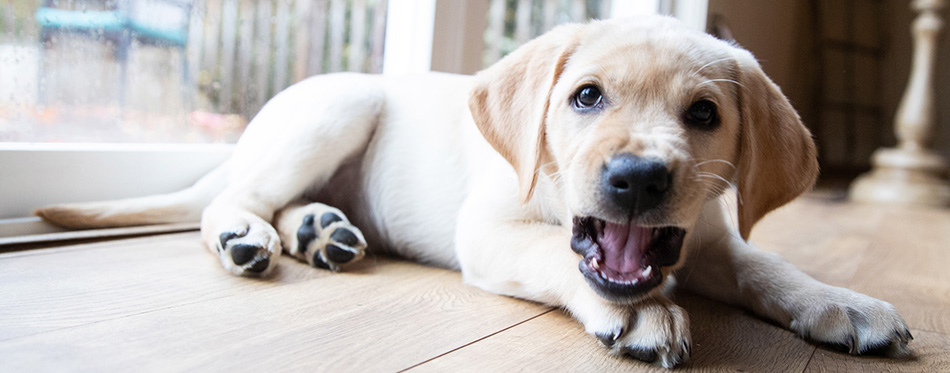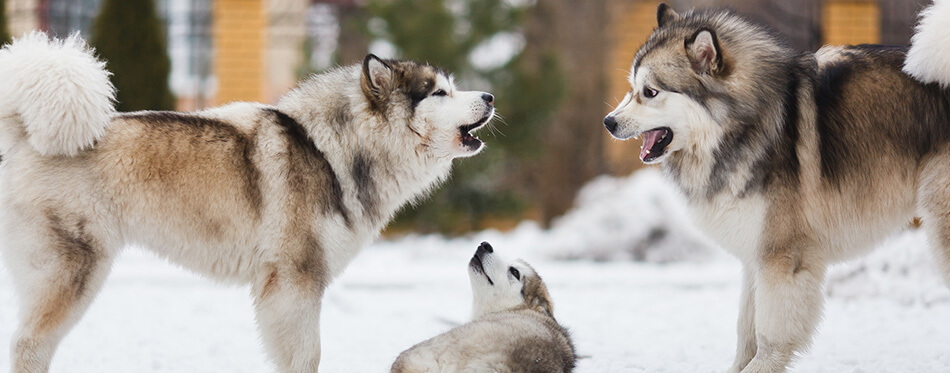All dogs growl and it’s not always for negative reasons. When he growls, your pooch is giving you a clear sign of how he is feeling, whether that’s a play growl to ask for more or an aggressive sign that all is not well. Understanding why your dog is growling and knowing the difference between a playful noise and a growl that is giving you a very real warning is key to working safely with your pet. We take a look at the growl as a communication tool and the main reasons your dog is getting vocal.

What Does it Mean When a Dog Growls?
Dog growling sounds are a canine form of communication. He may not be able to tell you whether he is happy, unhappy or downright annoyed so will use sounds, along with his body language, to get his point across. And, as dog parent, it’s essential you take the time to understand the subtle – and perhaps not so subtle – clues as to how your pooch is feeling. Dogs will also growl for many different reasons – from playful enthusiasm and mealtime pleasure to downright fear – and there will be differences in the growling sound, its pitch and volume. So, recognizing these differences as well understanding the context for your dog’s vocal warning means that you can respond appropriately to his message.
You may also like our article on Dog Whistles.
Why do Dogs Growl?
Occasional growling should not be too much of a problem, as long as it’s not aggressive, but working out the reasons behind your dog’s growling can help to prevent it becoming a more serious problem. Here are the main reasons why your pet may growl:
- Play
Growling is not always a bad thing, as you have most likely noticed when playing with your dog. Growling during play indicates your doggo is having a whole heap of fun and could also be a signal that he wants you to keep on playing. The tone of the dog purring growl will be different to something more aggressive; it will sound higher pitched and each growl will be shorter, often accompanied by body language such as bounding or crouching with his canine butt in the air. In short, he will come across as a growling goofball and this high-energy play should not be a problem.
- Pleasure
It may sound a little odd, but dogs will actually growl when experiencing pleasure, like a belly rub or tickle behind the ear. This behavior is similar to a cat purring and indicates he is happy, and probably doesn’t want you to stop! Such a pleasure growl will be low and last longer than other, perhaps ‘not so happy’ growls. Some dogs growling when petted may also accompany it with bearing of teeth and a little writhing, especially if you have hit their pleasure spot. Overall, such pleasure growling is nothing to be worried about, and is in fact an indication you are doing something right.
- Pain
Pain caused by injury or illness is another reason for your dog growing and is also an indication of their confusion and fear. You may find your normally placid and friendly dog starts growling at the vet when he is being examined and is a warning to the stranger that he is scared. However, if your dog is looking under the weather and is growling more, especially when you try to go near or touch him, it is always wise to get him checked out by a veterinarian as soon as you can as your dog is trying to tell you something is wrong.
- Frustration
Growling can also be a sign of frustration in your dog, especially when he feels his needs are not being met. A build-up of frustrated tension can lead to growling, such as when he is getting tired of waiting for his dinner or he sees another dog outside and really wants to go out to play. The problem with frustrated growling is that it can often be misinterpreted as more aggressive vocalization and can cause another dog to react. The secret to this type of growling is to avoid situations where your pet’s frustration spills out; alternatively, obedience training can help to diffuse the situation.
- Fear
Fear is another cause of your dog being a growler and, in some dogs, especially if neglected or abused, growling can become a problematic, dog snarling response. A fearful growl can be a dog’s natural reaction to a stranger approaching, if they are suddenly surprised or feel wary of a new situation. A fear growl is a clear message to back off and is a way for the dog to try and put some distance between them and the perceived danger or threat. However, a fearful dog is not wanting to fight, but is trying to appear menacing so they can be left alone. Again, a fearful growl is quite distinct and typically starts as a low rumble, with the dog’s body language reinforcing the message of ‘leave me alone’. Left unresolved, a fearful growl can escalate into something more aggressive and confrontational and so it is essential that the stressor is removed.
- Possessiveness
Some dogs are possessive, and this behavior can trigger associated growling if they feel threatened or fear their possession is going to be taken away. Food, toys, people, territory – possessive dogs will use growling to protect what they think is rightfully theirs and to scare others (dogs or people) away. In the most basic sense, a possessive growl is a pure warning and isn’t intended to be aggressive, they just want to let you, or others know that you are encroaching on their possession or personal space.
- Aggression
Aggressive growling is the one to really look out for as it is an expression of power on behalf of the dog and can result in physical action. There is usually no doubt about an aggressive growl; it is loud and low and can rumble on, accompanied by agitated changes in the dog’s demeanor. You will most likely also see bared teeth, as well as aggressive snarling. It is the complete opposite to fearful growling, which wants you or the perceived threat to go away. Aggressive growling is a precursor to closing that distance and potential attack, and as such can be very dangerous. Taking your own personal safety into account, aim to take your pet away from the trigger source of their aggressive growling. Professional help is advised if your dog has succumbed to this type of growling.
Check out our guide on Dog Anti Chew Spray.
The Difference Between Play and Fight Growling
Even if your pooch is having playfight fun with his canine bud, the growling is not always the nicest sound to hear. But knowing the difference between a harmful playfight growl and a more serious altercation is important, to prevent fun escalating to something more unpleasant. Playfighting is harmless and fun for your dogs, as long as they have been sufficiently socialized and can work within the playfight ‘rules’. A less socialized, trained pet can miss the verbal growling cues of a play session and fail to exercise the necessary restraint that can lead to a real fight.

What to do if you are Concerned About Your Dog’s Growling
Growls are a sign that your dog is trying to tell you something and they should not be ignored. However, you will be able to tell the difference between a contented or playful growl and something much more urgent and aggressive.
If your dog tends to make growling sounds when he plays and the rest of his body language – wagging tail, submissive crouching, bounding around – is upbeat and non-threatening, then there is no harm in this happy vocalization. The same goes with pleasure growling. It is when the growling becomes prolonged, demanding or over-persistent, escalating to undesirable or even threatening behavior, it is something that needs to be nipped in the bud. And never ignore growling that indicates pain or fear as your pet is asking you to do something to help them.
Ways to deal with undesirable growling include:
- Calling time out on a play session that’s going too far when it comes to growling. A short break can calm everything down and prevent play growling becoming fight mode.
- A pleasure growler that is demanding too much attention, may be craving stimulation. Take them for a walk, play with them or get them a new puzzle toy to divert their energies onto something more productive.
- Frustration or possessive growling may indicate the need to revisit some basic obedience training.
- You may also need to look at your own leadership skills as you need to be positioned as your dog’s alpha and they need to respond accordingly, without the need to growl to get what they want.
- Ensure all their core needs – food, water, toilet breaks, play, exercise and sleep time – are met consistently.
- If you suspect your dog’s growling and fearful body language is due to sickness, get them checked out by your vet so he can rule out or treat any underlying injuries or health issues.
And finally, always seek help and advice if your dog is an aggressive growler as left unchecked, they can become dangerous. Your vet or an animal behavior specialist can help you to work out what to do – for the welfare of both you and your pet.

